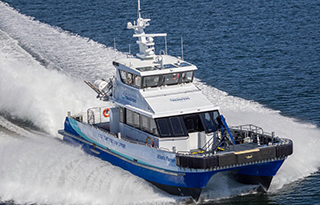The first U.S.-flag offshore wind energy service vessel was christened Friday at Quonset Point, R.I., in a step that puts Rhode Island at the head of a nascent East Coast wind energy industry.
“What better way to celebrate Earth Day than with … the first of its kind vessel in Rhode Island,” Gov. Gina Raimondo said at a dockside ceremony with operators Atlantic Wind Transfers at their North Kingston, R.I., terminal.
The 70’6”x24’x4’ Atlantic Pioneer is the first U.S.-built crew transfer vessel (CTV) engineered specifically to service offshore wind turbines.
The $4 million aluminum catamaran will enter service in May, carrying workers and up to 15 tons of equipment at service speeds of 24 to 25 knots out to the 30-megawatt Deepwater Wind LLC power project now under construction off Block Island.
Built by Blount Boats, Warren, R.I., the 70’6”x24’x4’ vessel is propelled with Hamilton waterjets powered by a pair of Tier III MAN V-12-1200CR engines, turning 1,200 hp at 2,100 rpm. Blount built the boat under license from South Boat IOW, a British boat builder and primary supplier to the European wind industry.
“It can do a spring speed of 30 knots. It could actually fill an Olympic swimming pool in 10 seconds,” said Charles Donadio, president of Atlantic Wind Transfers. Built around the need to transport up to 16 technicians in safety and comfort offshore, the boats is also certified to carry up to 47 passengers in mild conditions, so it can be used for tours of the Block Island project, he said.
“It performs very well. It’s an upgrade to the boats we use in the U.K., with bigger engines and drives,” said T.J. Bailey with SeaCat Services who has been training crew. “The result is brilliant, actually.”
In the pilothouse the captain sits in a centered console with joystick controls, facing a suite of Furuno radars and instrumentation.
“It’s very agile. The jets are a little overpowered, so it’s very easy to maneuver around the turbines,” said vessel captain Chris Anderson.
The crew transfer part is accomplished with a unique fendering system designed for the European industry. The black rubber heats through friction upon contact with the base of a turbine tower, effectively gripping the structure while technicians and equipment disembark.
“You bump up to make contact, then put some horsepower into it,” explained Luther H. Blount III, Blount's director of engineering. "The energy translates to heat and adhesion."
IMTRA Corp., New Bedford, Mass., supplied Decca straight-line wipers that clear 90% of the wheelhouse windows, and lighting, including a Colorlight CL20 halogen dual-lamp searchlight. Able to rotate through a full 360° on two axes, it can which illuminate all parts of the 570’ high turbines from directly underneath. On deck and below, light emitting diode lamps by IMTRA illuminate safer and more comfortable working environments for crew. In the engine room, LED engine room lamps provide bright, cool white light for easier engine inspection and maintenance easier. Walkways are illuminated by F25 lights and cockpit spreaders throw light across the decks.
The 21-meter vessel is the midsize in South Boat’s lineup of wind farm CTVs.
Blount CEO Marcia Blount said her company is poised to build more boats as needed for other, bigger East Coast wind ventures, as the Bureau of Ocean Energy Management makes wind leases available.
After the five Block Island turbines are complete, the Atlantic Pioneer will serve in operations and maintenance support. Atlantic Wind Transfers, a subsidiary of Rhode Island Fast Ferry Inc., has a 20-year service agreement with Deepwater Wind. “This is a service vessel,” said Deepwater president and CEO Jeff Grybowski. “That means this wind farm is tangible.”





